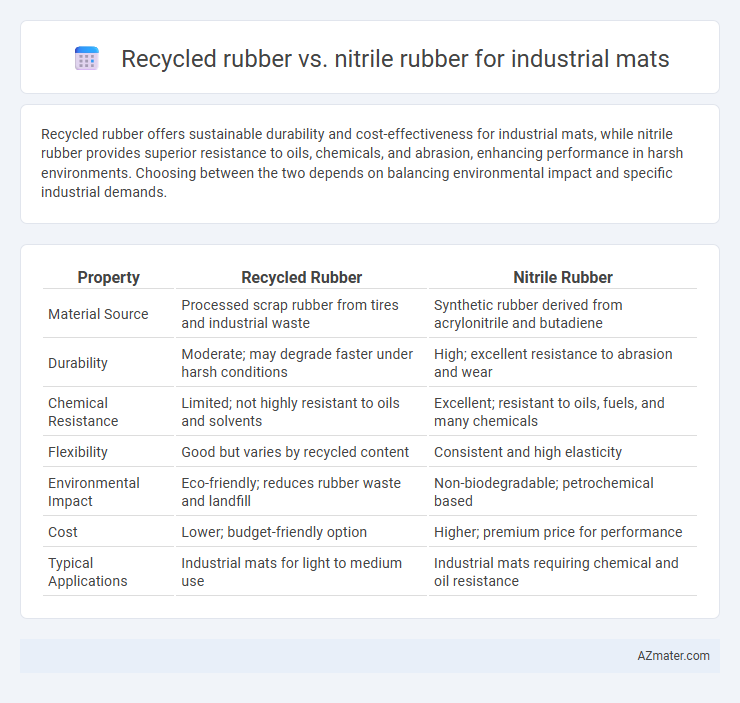Recycled rubber offers sustainable durability and cost-effectiveness for industrial mats, while nitrile rubber provides superior resistance to oils, chemicals, and abrasion, enhancing performance in harsh environments. Choosing between the two depends on balancing environmental impact and specific industrial demands.
Table of Comparison
| Property | Recycled Rubber | Nitrile Rubber |
|---|---|---|
| Material Source | Processed scrap rubber from tires and industrial waste | Synthetic rubber derived from acrylonitrile and butadiene |
| Durability | Moderate; may degrade faster under harsh conditions | High; excellent resistance to abrasion and wear |
| Chemical Resistance | Limited; not highly resistant to oils and solvents | Excellent; resistant to oils, fuels, and many chemicals |
| Flexibility | Good but varies by recycled content | Consistent and high elasticity |
| Environmental Impact | Eco-friendly; reduces rubber waste and landfill | Non-biodegradable; petrochemical based |
| Cost | Lower; budget-friendly option | Higher; premium price for performance |
| Typical Applications | Industrial mats for light to medium use | Industrial mats requiring chemical and oil resistance |
Introduction to Industrial Mat Materials
Recycled rubber and nitrile rubber are primary materials used in industrial mats, each offering distinct advantages for durability and chemical resistance. Recycled rubber provides an eco-friendly option with excellent shock absorption and wear resistance, making it suitable for heavy-traffic areas. Nitrile rubber excels in oil, fuel, and chemical resistance, ensuring long-lasting performance in harsh industrial environments where contamination is a concern.
Overview of Recycled Rubber
Recycled rubber, derived from processed scrap tires and industrial waste, offers an eco-friendly and cost-effective option for industrial mats, providing excellent durability and cushioning. It exhibits strong resistance to abrasion, weathering, and impact, making it suitable for high-traffic and heavy-duty environments. The sustainable nature of recycled rubber supports waste reduction and resource conservation in industrial applications.
Overview of Nitrile Rubber
Nitrile rubber (NBR) is a synthetic elastomer known for its exceptional resistance to oils, fuels, and chemicals, making it ideal for industrial mats in harsh environments. Compared to recycled rubber, nitrile rubber offers superior durability, excellent tensile strength, and enhanced resistance to abrasion and temperature variations. Industrial mats made from nitrile rubber provide long-lasting performance and reliable protection in automotive, manufacturing, and chemical processing settings.
Durability Comparison: Recycled vs Nitrile Rubber
Recycled rubber mats offer high durability with excellent resistance to wear, abrasion, and environmental elements, making them suitable for heavy industrial use. Nitrile rubber mats excel in chemical resistance and maintain durability under exposure to oils, fuels, and solvents, outperforming recycled rubber in harsh chemical environments. Overall, nitrile rubber provides superior durability in chemically demanding applications, while recycled rubber offers robust physical resilience and eco-friendly benefits.
Chemical Resistance and Spill Protection
Recycled rubber offers moderate chemical resistance suitable for general industrial mat applications but may degrade when exposed to harsh chemicals like oils and solvents. Nitrile rubber excels in chemical resistance, providing superior protection against oils, fuels, and various industrial chemicals, making it ideal for environments with frequent spills. Its spill protection capabilities ensure extended durability and safety in industrial settings where exposure to aggressive substances is common.
Sustainability and Environmental Impact
Recycled rubber mats significantly reduce landfill waste by reusing scrap tires and industrial rubber, contributing to a circular economy and lower carbon emissions compared to virgin materials. Nitrile rubber mats, while offering superior chemical resistance and durability, are petroleum-based and less biodegradable, posing greater environmental challenges over their lifecycle. Choosing recycled rubber enhances sustainability through resource recovery and reduced environmental footprint, whereas nitrile emphasizes performance with a higher ecological cost.
Cost Efficiency Analysis
Recycled rubber offers a cost-efficient solution for industrial mats due to its lower raw material and manufacturing expenses compared to nitrile rubber. Nitrile rubber provides superior resistance to oils, chemicals, and abrasion, which can reduce replacement frequency and maintenance costs in harsh environments. Balancing initial investment with durability and application-specific performance is critical for optimizing total cost efficiency in industrial mat selection.
Performance in Harsh Environments
Recycled rubber offers moderate abrasion resistance and flexibility but may degrade faster under extreme temperatures and chemical exposure compared to nitrile rubber. Nitrile rubber excels in harsh environments due to its superior resistance to oils, fuels, and chemicals, maintaining durability and elasticity across temperature extremes from -40degC to 120degC. Industrial mats made from nitrile rubber provide longer-lasting performance and safety in demanding conditions such as manufacturing plants, automotive workshops, and chemical processing facilities.
Safety and Slip Resistance Features
Recycled rubber industrial mats offer exceptional slip resistance due to their textured surface and inherent durability, making them ideal for high-traffic environments requiring enhanced safety. Nitrile rubber mats provide superior chemical resistance and withstand oil and grease exposure while maintaining excellent slip-resistant properties, critical in industrial settings with harsh substance contact. Both materials ensure worker safety, but nitrile excels in environments prone to chemical spills, whereas recycled rubber is favored for eco-friendly, high-traction floor solutions.
Choosing the Right Rubber Mat for Your Industry
Recycled rubber mats offer eco-friendly durability and excellent resistance to abrasions, making them ideal for industries aiming to reduce environmental impact while maintaining affordability. Nitrile rubber mats provide superior chemical resistance and enhanced durability against oils, fuels, and solvents, essential for automotive and manufacturing sectors. Selecting the right industrial mat depends on the specific exposure conditions and performance requirements, with recycled rubber suited for general wear and nitrile rubber preferred where chemical resistance is critical.

Infographic: Recycled rubber vs Nitrile rubber for Industrial mat
 azmater.com
azmater.com